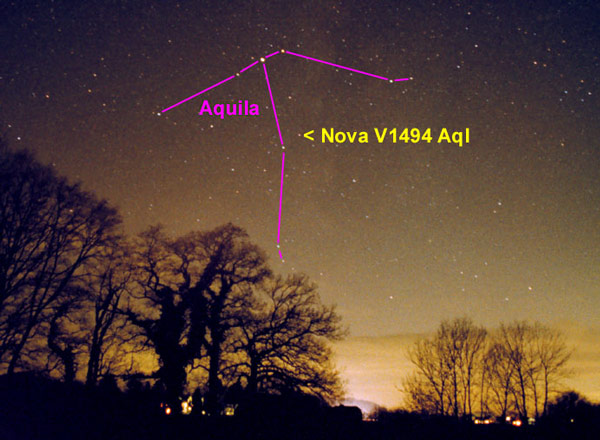Credit & Copyright: Till Credner
Explanation:
On December 1st,
experienced
observers patroling the night sky
with binoculars noticed what seemed to be
a new star in the constellation
of Aquila (The Eagle).
It wasn't really a new star though.
A comparison with detailed skymaps revealed the amazing truth,
there was a known star at that position in the sky ... its brightness
had simply increased by about 70,000 times.
The star, now fondly known to
variable star observers as Nova
V1494 Aquilae, continued to grow brighter for several days,
becoming easily visible to the unaided eye before starting
to slowly fade away.
Its position within the constellation is indicated on
this wide-angle picture taken on December 4th, near the time
it was brightest.
What would cause a star to undergo such a cataclysmic change?
This "new star" appears to be a
classical nova.
Classical novae are thought to be
interacting binary star systems in which one of the pair
is a dense, hot white dwarf.
Material from the companion falls onto the surface of the white dwarf,
building up until it triggers a thermonuclear blast.
A stunning increase in brightness and an expanding shell of
debris result - but the binary system is likely not destroyed!
Classical novae are
believed to recur as the flow
of material resumes and produces another outburst
in perhaps hundreds of years time.
1999 2000 2001 2002 2003 2004 2005 2006 2007 2008 2009 2010 2011 2012 2013 2014 2015 2016 2017 2018 2019 2020 2021 2022 2023 2024 2025 |
Январь Февраль Март Апрель Май Июнь Июль Август Сентябрь Октябрь Ноябрь Декабрь |
NASA Web Site Statements, Warnings, and Disclaimers
NASA Official: Jay Norris. Specific rights apply.
A service of: LHEA at NASA / GSFC
& Michigan Tech. U.
|
Публикации с ключевыми словами:
nova - white dwarf - classical nova - V1494 Aquilae - Тесные двойные системы - новые звезды - термоядерные реакции - аккреция - белый карлик
Публикации со словами: nova - white dwarf - classical nova - V1494 Aquilae - Тесные двойные системы - новые звезды - термоядерные реакции - аккреция - белый карлик | |
См. также:
Все публикации на ту же тему >> | |
